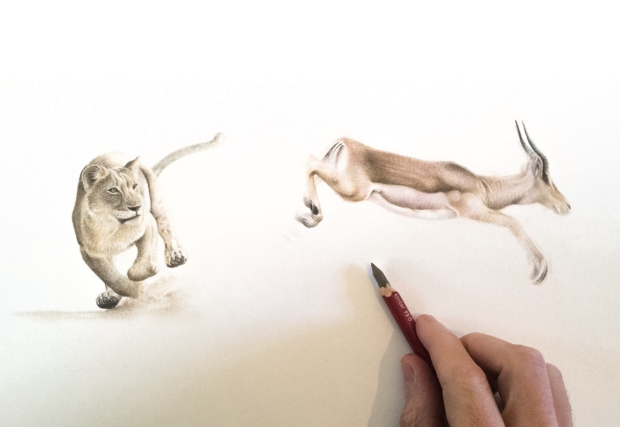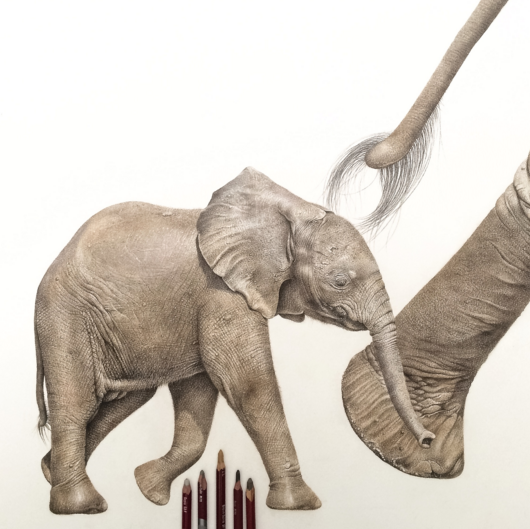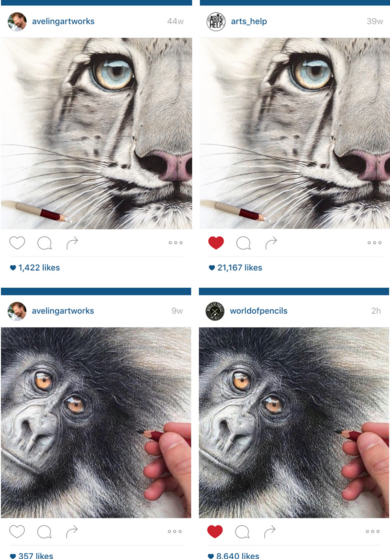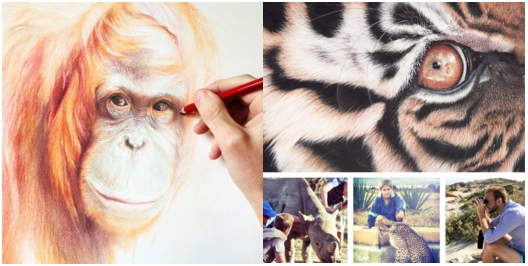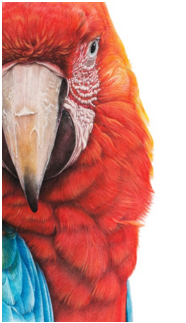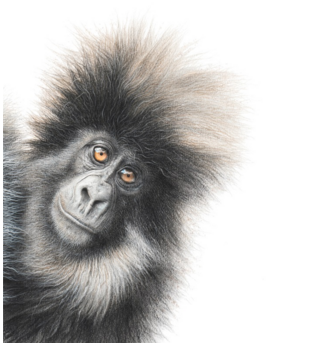Contributing to Conservation in a Creative Way
I first met wildlife artist Martin Aveling at the beginning of 2015 when I was working in South Africa. Anyone with this much talent coupled with a commitment to mitigating the plight of endangered species, is someone you need to know about in the conservation world.
Martin grew up in the savannah of Central and East Africa, born to two primatologists’ endeavouring to save the endangered Mountain Gorillas in Virunga National Park. The Virunga volcanoes are straddled between two countries that have been stifled with corruption, poaching and war; the Democratic Republic of Congo and Rwanda. However it was growing up in this heterogeneous lifestyle, amid undoubtedly one of the world’s most biologically diverse and beautiful biome and concomitantly also one of the most dangerous places to live, that has produced such a discerning and emotive wildlife artist.
Martin kindly agreed to answer a few questions in order to help us gain insight into Martin’s success and to pass on his guidance for future conservationists using wildlife art as a career path.
Martin, what first got you interested in drawing wildlife?
While my parents were working to conserve mountain gorillas, I picked up pencils and drew what was around me. Living in remote rural areas without the trappings of modern life to entertain an energetic three year old, they soon discovered that a pad of paper and a few coloured pencils would happily distract me for hours on end.
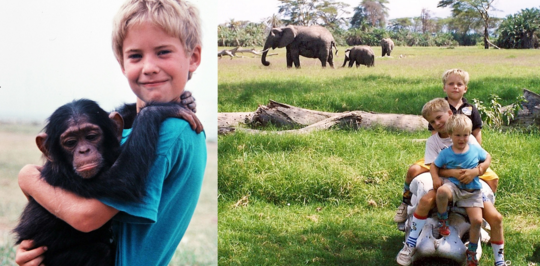
Left: Martin with an orphaned chimpanzee, confiscated by park officials investigating the illegal pet trade in DRC. Right: Martin and his two brothers at the Amboseli elephant research camp in Kenya on Christmas day.
What is your speciality or favourite technique in art?
My favourite medium to work in is pastel pencils. I’ve used it for over half my life ever since my mum gave me a boxed set for my GCSE art exams. The fluid nature of the pencils requires a lot of reworking and therefore time. My technique is to build up layers of colour and detail, using a light spray of fixative as I go. The detail recedes slightly with each spray, but then re-working on top of the sprayed area with the pastels makes it re-emerge with embedded texture. I enjoy the process, and for the most part have the required patience, although I do occasionally find it beneficial to start on something new before returning to that piece with fresh eyes. The lengthy nature of the process does mean I have to reflect the time invested when pricing my work, but I feel it’s quality over quantity when it comes to this!
Being a wildlife photographer or artist can be very competitive these days. How would you suggest people stand out from the crowd, and what would you advise budding wildlife artists to do in order to break into the industry?
As with most things, hard work and persistence pays dividends. Luck can occasionally play a part in life, but rather than waiting around for it to arrive, you can also take steps to create your own luck. To quote the golfing legend and wildlife champion, Gary Player – “The harder I practice, the luckier I get!”
My advice would be to try and be distinctive. Aim to make your name synonymous with your work, and use all the free tools at your disposal to get your art seen by people. Love it or loath it, social media is a great tool for promoting your work to a global audience. I regularly post my works in progress on Facebook or Instagram and find the responses a useful gauge to decide whether or not something is working. Facebook has over 1.5 billion monthly active users. I see this as an opportunity to have a gallery shop window with a mammoth footfall!
How do you think your work raises awareness and contributes to conservation?
Being so focused on wildlife it is impossible not to connect with how under threat my subjects are in so many parts of the world. Using my art to support conservation groups like Fauna & Flora International, Elephant Family and the David Shepherd Wildlife Foundation helps me feel more optimistic about the future of iconic creatures like rhinos, big cats, turtles and primates. Several of my exhibitions have benefitted conservation groups and it was pastel pencils I turned to when asked to draw the first illustration of the newly discovered Myanmar snub-nosed monkey. I have enjoyed taking part in some public art campaigns, turning to paints and preformed elephants, crocodiles and giant eggs to create items for display in cities that were then auctioned for the charities concerned.
Through social media I have had the privilege of engaging with experts in the fields of science, sport and entertainment who share a passion and understanding for the need to safeguard the future of our planet and its wildlife. This has resulted in many of them backing conservation projects I have set up or been involved with. In my view a career in wildlife art is a career in conservation, and I believe the two are not mutually exclusive.
Where do you find the most inspiring wildlife photographs to emulate?
The detailed nature of my work does mean I rely in part on photo reference. However I strongly feel that my early exposure to wildlife has given me a solid grounding in appreciating how my subjects look and move in all their three-dimensional, fleshy glory when translating them to the page with pencils.
Where possible, I like to take my own reference photos. It’s a nice excuse to get out of the studio and top up my sense of wildlife and wild places! It does not take long however before I start to yearn for the studio, to be back translating those sights and senses onto paper. I do receive commission requests for a wide array of animal subjects, and so where it’s not possible to take my own photos I have established relationships with wildlife photographers around the world who live in closer proximity to those animals.
Can you describe a typical day in the life of a wildlife artist?
Totally unstructured! That’s the case for me anyway. It’s hard to predict when the inspiration will come. It might be late at night working under the daylight lamp when I suddenly feel I’ve hit a purple patch. In this instance I’ll usually try and capitalise on that momentum, often putting the pencils down long after midnight.
It can be quite an insular profession, spending hours and days in the studio with just yourself or the radio for company. I counteract this mentally by keeping in touch with friends and supporters on social media, and responding to website enquires. As long as I feel like I’ve put in enough time on the pastels, it doesn’t matter what time in the day the drawing happens.
Have you ever received any rejections in your career, if so how did you deal with this?
Plenty! Rejection is par for the course in the creative world, but you can’t let it get you down. A few years back when I was only just starting out in my professional career, I had a big exhibition planned with a renowned UK zoo. After having spent several months preparing a portfolio, they pulled the plug at the last minute without much explanation. It was hard to accept at the time, but I’ve learnt to remain strong in the face of disappointment, and rather than seeing it as wasted time I’ll see it as most of the work done for the next exhibition! Back yourself, and another bigger and better opportunity will be just around the corner.
Do you have any exhibitions coming up and where can people get hold of prints of your work?
After 4 years of back-to-back solo exhibitions, I have used 2015 to focus on commissions and adding to my general portfolio of artworks. I always submit one or two pieces for the David Shepherd Foundation’s ‘Wildlife Artist of the Year’ exhibition, which takes place in London at the beginning of summer. This is one of the premier exhibitions of its kind, bringing together wildlife artists from across the globe under one roof for a spectacular exhibition of art inspired by the natural world. It’s an unmissable date in the calendar for me, and always the most humbling of occasions. With soaring incidents of wildlife crime taking place across the world, it is easy to get despondent about the future of our planet and its wild animals. The David Shepherd foundation uses art to help fund conservation projects around the world, and it is initiatives like this that gives one a renewed sense of hope. Creative minds collaborating to give back to what inspired them to take action in the first place.
I am currently looking at opportunities for another solo show in the next couple of years, and I also have a small selection of limited edition prints for sale in the online shop of my website : https://www.avelingartworks.com
Finally, what is your favourite wildlife encounter or animal you have had the privilege of drawing?
You’ve saved the hardest question for last! If pushed I would have to say my most memorable and vivid wildlife experience was spending time with a family of Mountain gorillas. Sir David Attenborough famously described his encounter with these Great Apes as experiencing “more meaning and mutual understanding in exchanging a glance with a gorilla than with any other animal I know.” I’ve certainly never felt more acutely aware of being observed than when sharing a space with these magnificent animals.
My favourite animals to draw are probably the birds of prey. The chalky nature of the pastel pencils favours feathers, and I enjoy the challenge of contrasting those delicate feathers with a powerful, waxy beak and glassy eyes. In fact, I have just started on a big portrait of a Bateleur Eagle, so watch this space for updates…
If you fancy seeing Martin at work check out the video below:
[youtube https://www.youtube.com/watch?v=Sn2gcwMFaBU?rel=0]

